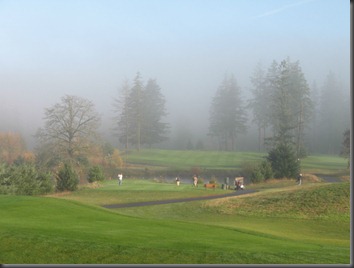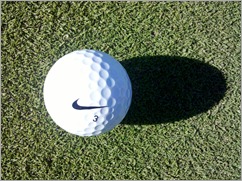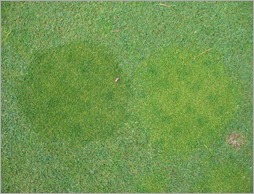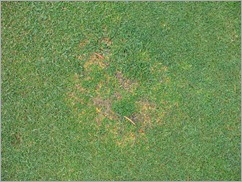Course Conditions It is November and the course is getting softer. The course looks great but if we drive where we aren’t supposed to be, you may leave a mess behind. The right of five is a good example of this. We pushed the rough mowing a little to far and it tracked up pretty bad. All superficial of course and will disappear soon.
It is November and the course is getting softer. The course looks great but if we drive where we aren’t supposed to be, you may leave a mess behind. The right of five is a good example of this. We pushed the rough mowing a little to far and it tracked up pretty bad. All superficial of course and will disappear soon.
We fertilized the greens on Friday. We will be increasing the iron rates as we get into the winter months. Many of the courses that escaped the winter wrath last year all had higher iron rates in common. I feel the iron will help harden off the grass and will enable it to tolerate the colder temperatures better. Last year we were using higher iron rates and we did in fact come through the December cold snap without any problems. We are also targeting some residual silver thread moss as well. We treated a few weeks ago with Quick Silver so now we are just treating it with the iron to avoid another herbicide application.
Poa Transition
As I was changing cups the other day I couldn’t help but notice the Poa annua invading the greens. It seems to be the fate of most all putting greens that I have ever been around. If it were possible, and didn’t require all kinds of chemical interactions, I would most definitely prefer to manage creeping bentgrass greens. Many golfers are fans of Poa greens by the fact that it is all they have ever played. This summer I happened to play some of the finest bentgrass greens I have ever set foot on at Proghorn Golf Club. Personally I would take those greens over Poa any day. The benefits of bent over Poa are many. First off, bentgrass has a far better disease resistance. In the time of reduced pesticide programs this is important not only for reduced inputs but the costs of a fungicide program to prevent common Poa annua diseases can cost up to $20,000 a year. Another benefit of bentgrass is its deep rooting ability. The deeper the roots the less dependent you have to be on water during the heat stress times of the year. This saves water and labor costs.
greens. It seems to be the fate of most all putting greens that I have ever been around. If it were possible, and didn’t require all kinds of chemical interactions, I would most definitely prefer to manage creeping bentgrass greens. Many golfers are fans of Poa greens by the fact that it is all they have ever played. This summer I happened to play some of the finest bentgrass greens I have ever set foot on at Proghorn Golf Club. Personally I would take those greens over Poa any day. The benefits of bent over Poa are many. First off, bentgrass has a far better disease resistance. In the time of reduced pesticide programs this is important not only for reduced inputs but the costs of a fungicide program to prevent common Poa annua diseases can cost up to $20,000 a year. Another benefit of bentgrass is its deep rooting ability. The deeper the roots the less dependent you have to be on water during the heat stress times of the year. This saves water and labor costs.
 a annua over the years. It has been found that Poa’s greatest advantage is its genetic diversity. We refer to it as a single variety but it is really a compilation of thousands of biotypes. This is why you will see two patches of Poa annual growing adjacent to each other yet one looks tight, has a dark color and the other may be light green and has more seed heads. This photo to the right was taken last week on our fifth green which demonstrates this perfectly.
a annua over the years. It has been found that Poa’s greatest advantage is its genetic diversity. We refer to it as a single variety but it is really a compilation of thousands of biotypes. This is why you will see two patches of Poa annual growing adjacent to each other yet one looks tight, has a dark color and the other may be light green and has more seed heads. This photo to the right was taken last week on our fifth green which demonstrates this perfectly.  dominate the stand. It is common to observe variable biotypes under various management regimes (Cline, 2001; Wu, 1991). This is why when you visit older courses such as Columbia Edgewater, Royal Oaks, or Orchard Hills, you will notice that their Poa greens aren’t seeding quite as much and their stands will seem more uniform. These greens have evolved over time and are now beautiful putting surfaces. Pictured to the left is Orchard Hills. These greens were amazing to putt on. By far the best Poa I played all year.
dominate the stand. It is common to observe variable biotypes under various management regimes (Cline, 2001; Wu, 1991). This is why when you visit older courses such as Columbia Edgewater, Royal Oaks, or Orchard Hills, you will notice that their Poa greens aren’t seeding quite as much and their stands will seem more uniform. These greens have evolved over time and are now beautiful putting surfaces. Pictured to the left is Orchard Hills. These greens were amazing to putt on. By far the best Poa I played all year. fungicide applications in the coming years. Up until now we have allowed the anthracnose to be a natural Poa control. This year we experienced wide spread anthracnose on much of our Poa populations to a point where it affected the ball roll. Anthracnose will be our main summer issue where Michodochium Patch or Pink Snow Mold will be our main winter issue. Both of which were none existent in our stand until now.
fungicide applications in the coming years. Up until now we have allowed the anthracnose to be a natural Poa control. This year we experienced wide spread anthracnose on much of our Poa populations to a point where it affected the ball roll. Anthracnose will be our main summer issue where Michodochium Patch or Pink Snow Mold will be our main winter issue. Both of which were none existent in our stand until now. 
No comments:
Post a Comment